#june revolt
Explore tagged Tumblr posts
Text
It’s a sad one. Because little Gavroche is “on his way to the wars” and thus, to his inevitable end. He has got his pistol without a trigger, and to obtain it, he had to drop a bunch of flowers. This imagery here is profoundly symbolic and extremely depressing.
Since we last encountered him, a lot of things seem to happen. He worked as an apprentice to a printer for three months! It’s a big deal, nearly the beginning of a carrier! Additionally, he has lost track of his two kids without any hope of ever finding them again. And heartless Hugo proposes several horrifying scenarios of what might have befallen them. Yet, I still hope they will be fine. I know that we are in the universe of Les Misérables, where nearly every story ends with a tragedy, but let’s pretend this one could be different.
35 notes
·
View notes
Text










The Bear Flag Revolt began on June 14, 1846. Anglo settlers in Sonoma, California, started a rebellion against Mexico and proclaimed the California Republic.
#Sonoma State Historic Park#rebellion#California Republic#summer 2022#evening light#Mission San Francisco Solano#architecture#cityscape#travel#General Mariano Guadalupe Vallejo by Jim Callahan#US flag#vacation#USA#Bear Flag Revolt#started#14 June 1846#anniversary#US history#public art#sculpture#exterior#tourist attraction#landmark#original photography
2 notes
·
View notes
Text
Margaret de Enges, the prioress of Norwich, was forced to give up the rent rolls of the house for burning by the mob in June, and Joan Colbrand's records room was plundered and she was beaten by a mob.
"Normal Women: 900 Years of Making History" - Philippa Gregory
#book quote#normal women#philippa gregory#nonfiction#margaret de enges#prioress#norwich#rent ledger#private documents#paperwork#burnt#mob justice#june#joan colbrand#records#plundered#beaten#peasants revolt#wat tyler's rebellion
0 notes
Text
Two other women were named as leaders in official documents:
Londoners Matilda Brembole, and h r daughter Isabella, were at the firing of the Savoy Palace, they tore to pieces cloth of gold and silver and rich tapestries, broke up the rich furniture, crushed the Duke's plate, and ground his jewels and precious stones under foot. All that could not be destroyed was thrown into the river. When the work of destruction was over, the Savoy lay a smouldering ruin.
"Normal Women: 900 Years of Making History" - Philippa Gregory
#book quotes#normal women#philippa gregory#nonfiction#londoner#matilda brembole#isabella brembole#savoy palace#june 13#gold#silver#tapestries#furniture#broken#destruction#ruin#jewels#precious stones#river#peasants revolt#wat tyler's rebellion
1 note
·
View note
Text
We have shown what printing large wood type in multiple ink colors looks like recently but we have received a lot of inquiries about what it would look like using one of our old letterpress cuts.
The order from left to right in the galley tray at the beginning is red, orange, yellow, green, blue, and purple. Some of the inks are oil base and some are rubber base. In this video, Jared letterpress printed a large halftone of the most prominent part of our state flag, the California Grizzly bear.
This halftone is a reproduction of Charles Nahl’s drawing, “Grizzly Bear,” which he designed in 1854. We also thought this print was great for this time, since June 14th is the anniversary of the Bear Flag Revolt and when the first Bear Flag was created.
#museum#sacramento#history#letterpress#printing#asmr#art#Bear#pride 2024#pride month#printmaking#oddly satisfying#rainbow
732 notes
·
View notes
Text





“Lucrezia Borgia was the daughter of Rodrigo Borgia, the powerful Renaissance figure who later became Pope Alexander VI, and Vannozza dei Cattanei. Her brothers included Cesare Borgia, Juan Borgia, and Gioffre Borgia. She served for a time as de facto ruler of the Holy See during her father's absence. The fall of the power of the Borgias followed with her father's death in 1503 despite Cesare's immense capabilities. Cesare, gravely ill, was planning the conquest of Tuscany, but could do nothing without continued papal patronage. The new pope, Pius III, supported him, but his reign was short and was followed with the accession of the Borgias' deadly enemy, Julius II. While moving to Romagna to quell a revolt, Cesare was seized and imprisoned near Perugia. All Borgia lands were subsequently acquired by the Papal States. After exile to Spain, in 1504, followed by imprisonment and escape, Cesare joined his brother-in-law, King John III of Navarre; dying in his service during a military campaign in 1507. Meanwhile, Lucrezia, no longer needing to play a major political role at the court of Ferrara — which became a center for the arts and letters of the Italian Renaissance —was able to live a more normal life and turned to religion in her final years. She died on June 24, 1519 at the age of 39, due to complications occurring during the birth of her eighth child.”
#tvedit#historyedit#perioddramaedit#lucrezia borgia#the borgias#by tha#zanisummers#usersjen#userhayf#tuserlou#userfish#userclayy#tusereliza#userzaynab#userlenna#usermyr#userhann#light of my life
418 notes
·
View notes
Text
"The Congo’s strategic location in the middle of Africa and its fabulous natural endowment of minerals and other resources have since 1884 ensured that it would serve as a theatre for the playing out of the economic and strategic interests of outsiders: the colonial powers during the scramble for Africa; the superpowers during the Cold War; and neighbouring African states in the post-Cold War era. To prevent a direct confrontation between the United States and the Soviet Union, the Security Council deployed from 1960 to 1964 what was then the largest and most ambitious operation ever undertaken by the UN, with nearly 20,000 troops at its peak strength plus a large contingent of civilian personnel for nation-building tasks.
This latter aspect of the Opération des Nations unies au Congo (ONUC) was a function of the fragile political revolution ... The Congo won its independence from Belgium on 30 June 1960. Patrice Lumumba’s MNC-L and its coalition of radical nationalist parties had captured a majority of seats in the lower house of parliament in the pre-independence elections in May. Lumumba became prime minister and head of government, while the Abako leader Joseph Kasa-Vubu became the ceremonial head of state. The victory of a militantly nationalist leader with a strong national constituency was viewed as a major impediment to the Belgian neocolonialist strategy and a threat to the global interests of the Western alliance.
Within two weeks of the proclamation of independence, Prime Minister Lumumba was faced with both a nationwide mutiny by the army and a secessionist movement in the province of Katanga bankrolled by Western mining interests. Both revolts were instigated by the Belgians, who also intervened militarily on 10 July, a day before the Katanga secession was announced. In the hopes of obtaining the evacuation of Belgian troops and white mercenaries, and thus ending the Katanga secession, Lumumba made a successful appeal to the UN Security Council to send a UN peacekeeping force to the Congo. However, the UN secretary-general, Dag Hammarskjöld, interpreted the UN mandate in accordance with Western neocolonialist interests and the US Cold War imperative of preventing Soviet expansion in the Third World. This led to a bitter dispute between Lumumba and Hammarskjöld, which resulted in the US- and Belgian-led initiative to assassinate the first and democratically elected prime minister of the Congo.
... Brussels’ failure to prevent a radical nationalist such as Lumumba from becoming prime minister created a crisis for the imperialist countries, which were determined to have a decolonization favourable to their economic and strategic interests with the help of more conservative African leaders. With Belgium’s failure to transfer power in an orderly fashion to a well-groomed moderate leadership group that could be expected to advance Western interests in Central and Southern Africa, the crisis of decolonization in the Congo required US and UN interventions. Working hand in hand, Washington, New York and Brussels succeeded in eliminating Lumumba and his radical followers from the political scene."
Georges Nzongola-Ntalaja, The Congo from Leopold to Kabila: A People's History, 2002
425 notes
·
View notes
Note
please GOD HELP ME. do you have any love poetry either single poems or book reccs im going THROUGH IT orz (<me curling up on the floor)
i’m picking you up off the floor and pressing this list of assorted love poems into your hand like a folded note. i hope you like them! 💌
to you and morning by frank o’hara
poem for my love by june jordan... honestly all of haruko/love poems (1994) is very good!
love (iii) by george herbert
on the reproduction of images by miriam alex
december by michael miller
o small sad ecstasy of love by anne carson
serenade by dilruba ahmed
amores (II) by ee cummings (the entire amores series, I through XI, are all so worth reading but this is my favorite of the bunch!)
my house by nikki giovanni
little crazy love song by mary oliver
romance by claude mckay
to revolt is to insist on joy by nur turkmani
there is only one of everything by margaret atwood (located on page 15 of this compilation!)
asking about you by eloise klein healy
love song by william carlos williams
poems for blok, 1 and where does such tenderness come from? / whence cometh such tender rapture? (< these are two different translations of the same poem and they are both striking lovely in their own way) by marina tsvetaeva
encounter in april by may sarton
we have not long to love by tennessee williams
laura, i want you pulling your hair back by natalie dunn
adore by li-young lee
you by carol ann duffy
after touching you, i think of narcissus drowning by leila chatti
summer was forever by chen chen
untitled by izzy wellwaterhysteria
and here is the new penguin book of love poetry (2003), borrowable via the internet archive!
#let me know if these are too familiar to you or overly pedestrian or whatever and i can absolutely compile some more!#asks#uploads
217 notes
·
View notes
Text
Cardverse: A Case Study (that really isn't one.)
Hello gaymers and happy new year! Today we will be revisiting an old official au called Cardverse. Keep in mind that this is going to be an entirely different version of it rather than canon Cardverse, and 90% of it will be just my sorry behind rambling about the wonders and glories of political relations and why IT SUCKS!!!!!!!!!!!!!!!!!!!! LETS GO.
🔶Kingdom of Diamonds🔶

Ruler: Our Majesty Francis Bonnefoy, King/Queen of Diamonds; Beside him Prime Minister Erika Vogel and Royal Financial Advisor Vasch Zwingli (spelt his name wrong ik.)
The Kingdom of Diamonds; one of the wealthiest kingdoms in the land with a very turbulent history. Centuries ago, the king and queen upheld the most power (aside from Lords and Aristocrats). This imbalance of power would spark a revolt that would last for decades until a new form of government was put into place. (Not really.)
The Kingdom of Diamonds lies South, known for their very warm climates which contribute to their bountiful crops. They are responsible for 75% of the food distribution to other neighboring kingdoms. They are sometimes subsequently referred to as the "Brighter South" due to the amount of sunshine that contributes to their warm climate. However, they are often hindered by bad storms and monsoons from June until November.
While still under a monarchy, the Diamonds kingdom has it's own prime minister that keeps everything and everyone in check, this includes the king (or queen). Erika and Vasch act as some sort of caretaker for Francis, making sure that he's safe and not frivolously spending his inheritance on useless things such as new land, etc. Some have said that the King/Queen is too incompetent to be ruling a kingdom due to several factors: His emotional sensitivity, him being a people pleaser, and his overly flamboyant nature. Other has praised the king in his efforts in helping improve the lives of his people and his kind nature.
♠️The United Spades♠️

Ruler: Commander in Chief and President Alfred F. Jones; beside him Vice President Arthur Kirkland, and Secretary of State Chun-Yan Wang
From a small monarchy to one of the largest democracies in the land, The United Spades (actual name The United Spades of Aces) holds a lot of power than one may know.
They reside North, having to deal with several harsh winters. The Spades Kingdom has many various industrial sites. Unfortunately because of this, it is said to be the kingdom with the highest recorded rate of pollution.
The birth of the Spade's democracy still remains under debate by some historians. Some may have suggested it had ended after the death of the President's mother, who was said to be the last Queen of what once was the Kingdom of Spades. Others may have concluded that it emerged at the end of some sort of civil war; though these events had coincided with each other. Despite these events, the Spades are relatively young.
While he holds much authority over everyone, Alfred does struggle to keep many things in check; some praise him for his hard work while others criticize him for hurting some aspect of his community.
❤️The Kingdom of Hearts❤️

Ruler: Queen S̶͕̯̳͇̰͉̬̻̈́̃̿̈́͌̎͝ä̵̡̡͉̮̦̼̻̬̦̭́̄̓͝ḱ̸̛̜͉̀͑̆̊̈̚͠ù̵͗̋̌͋̇̌̏͋��̨̠̤͚̥̻r̷͇̫̱̩̗̥̺̋̀͜͝a̵̢͕̯̙̓͐̔̓ ̶͇̜̯͍͍̥̩̟̹̣͗̀͛̔̍͑̈̕H̵̢͖͖͊͘ö̷̡̤̱̟̬̗̲́̆͂̾̇̊̚͠ń̶̢̧̠̓̂̚͜d̵̘͚̟̲̮͙͚̮͚̃́͛͋͒͐̄a̵̢͕͔̜̙͂̈́͌̅̈́͜ Lucrezia Vargas and King Ludwig Beilschmidt of the Hearts Kingdom.
The Hearts Kingdom resides in the western portion of the lands, also known as the "Western Kingdom" or "The Wild West". Much like the Empire of Clubs, they have a very fair climate. Average to the point where there is not much to comment on.
Not much is known about the Heart's Kingdom or what it's known for. It is rumored that the current queen isn't the real queen, and that something must've happened behind closed doors. Despite Ludwig being king and having the same amount of power, Lucrezia has the most authority over everybody. There is something about her that'll give you an aching feeling in your gut. But who is Sakura?
♣️The Empire of Clubs♣️

Ruler: Emperor Ivan Braginsky and Empress Elizabeta Hedevary and Jack of all trades Clubs Roderich Edelstein
The Empire of Clubs lies just to the east, majority of its territory landlocked by mountains and valleys. It's a place where not much goes on, not even among the monarchs who hold the power of the world within their hands. Some travelers from other kingdoms will return with how reserved most of the people are, giving them this quiet reputation.
Although quiet, they are well known for their clean environment and vast green valleys. Because of this they have a very diverse ecosystem and dedicate their fundings to preserving the homes of many species whether by land or by sea. It is even rumored that Ivan has a giant pet polar that was stolen from a neighboring kingdom elsewhere. Although due to the privacy of the royals, this cannot be confirmed nor denied.
#aph hetalia#hetalia axis powers#hetalia#axis powers ヘタリア#hetalia world stars#hetalia fanart#aph#hws#hws hetalia#ヘタリア#ヘタリア world stars#ヘタリアaxispowers#cardverse au#cardverse#nyotalia#aph america#aph england#aph france#aph russia#aph china#nyo china#aph germany#aph italy#nyo italy#aph north italy#aph japan#hws japan#aph austria#aph hungary#aph liechtenstein
55 notes
·
View notes
Text
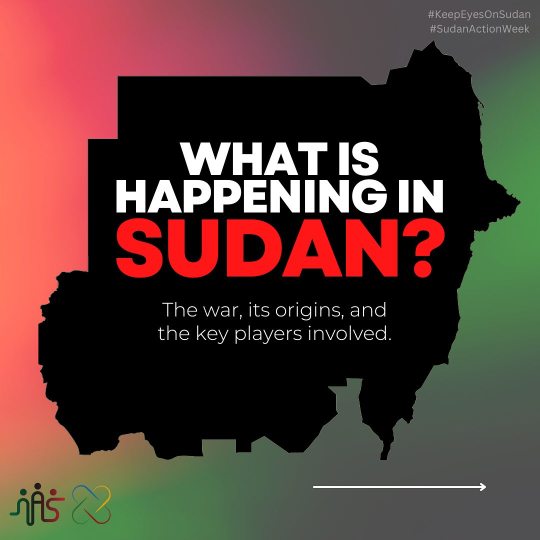
Via NasAlSudan
December 17 2023. #KeepEyesOnSudan #SudanActionWeek
Swipe through to build a foundational understanding of the war, its origins, and the key players involved. For actionable ways to support those in Sudan, check the link in our bio. Stay tuned for more posts this week.
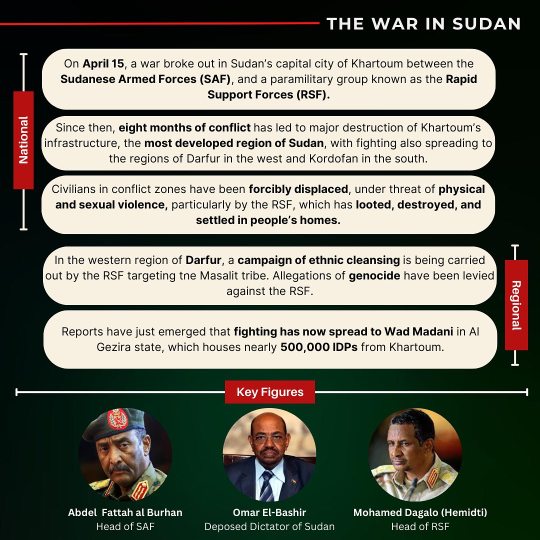
Transcript:
National:
On April 15, a war broke out in Sudan's capital city of Khartoum between the Sudanese Armed Forces (SAF), and a paramilitary group known as the Rapid Support Forces (RSF).
Since then, eight months of conflict has led to major destruction of Khartoum's infrastructure, the most developed region of Sudan, with fighting also spreading to the regions of Darfur in the west and Kordofan in the south.
Civilians in conflict zones have been forcibly displaced, under threat of physical and sexual violence, particularly by the RSF, which has looted, destroyed, and settled in people's homes.
Regional:
In the western region of Darfur, a campaign of ethnic cleansing is being carried out by the RSF targeting the Masalit tribe. Allegations of genocide have been levied against the RSF.
Reports have just emerged that fighting has now spread to Wad Madani in Al Gezira state, which houses nearly 500,000 IDPs from Khartoum.
Key figures:
Abdel Fattah al Burhan Head of SAF
Omar El-Bashir Deposed Dictator of Sudan
Mohamed Dagalo (Hemidti) Head of RSF

Transcript:
Sudan: the war in numbers
A humanitarian "catastrophe"
24.7 million in need of critical humanitarian assistance
70-80% of hospitals out of service in conflict areas
19 million children are out of school
20.3 million people acutely food insecure. 4.9 million facing emergency hunger levels
6.7 million displaced [5.4 million IDPS, 1.3 million refugees]
7,000+ cholera cases an increase of +136% over the past month
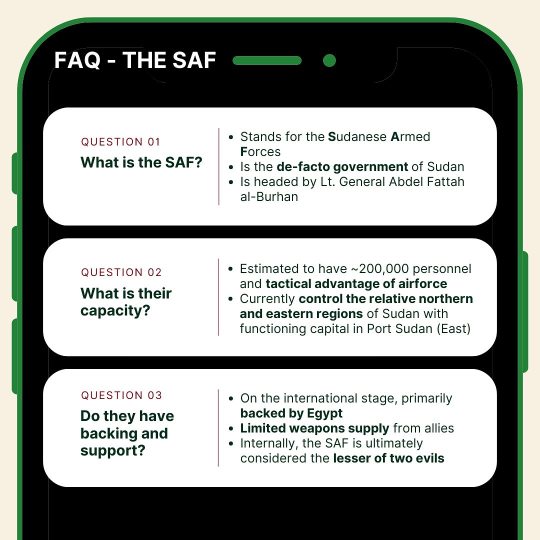
Transcript:
FAQ - THE SAF
QUESTION 01: What is the SAF?
Stands for the Sudanese Armed Forces
Is the de-facto government of Sudan
Is headed by Lt. General Abdel Fattah al-Burhan
QUESTION 02 What is their capacity?
Estimated to have ~200,000 personnel and tactical advantage of airforce
Currently control the relative northern and eastern regions of Sudan with functioning capital in Port Sudan (East)
QUESTION 03 Do they have backing and support?
On the international stage, primarily backed by Egypt
Limited weapons supply from allies
Internally, the SAF is ultimately considered the lesser of two evils
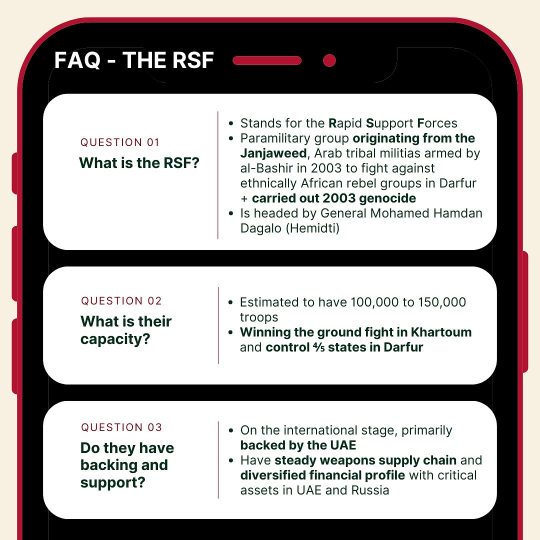
Transcript:
FAQ - THE RSF
QUESTION 01 What is the RSF?
Stands for the Rapid Support Forces
Paramilitary group originating from the Janjaweed, Arab tribal militias armed by al-Bashir in 2003 to fight against ethnically African rebel groups in Darfur + carried out 2003 genocide
Is headed by General Mohamed Hamdan Dagalo (Hemidti)
QUESTION 02 What is their capacity?
Estimated to have 100,000 to 150,000 troops
Winning the ground fight in Khartoum and control 4/5 states in Darfur
QUESTION 03 Do they have backing and support?
On the international stage, primarily backed by the UAE
Have steady weapons supply chain and diversified financial profile with critical assets in UAE and Russia
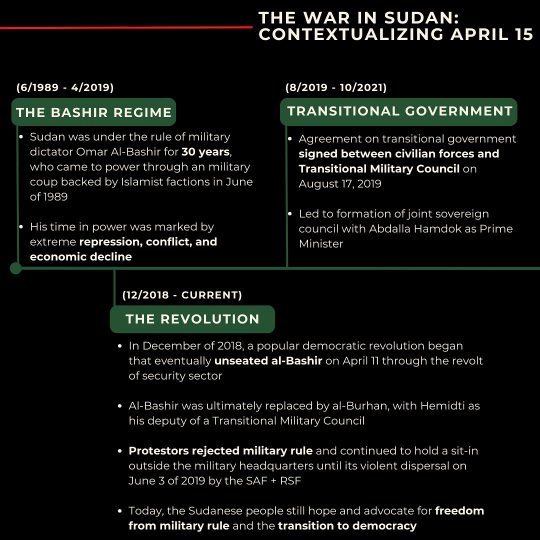
Transcript:
THE WAR IN SUDAN: CONTEXTUALIZING APRIL 15
(6/1989 - 4/2019) THE BASHIR REGIME
Sudan was under the rule of military dictator Omar Al-Bashir for 30 years, who came to power through an military coup backed by Islamist factions in June of 1989
His time in power was marked by extreme repression, conflict, and economic decline
(12/2018 CURRENT) THE REVOLUTION
In December of 2018, a popular democratic revolution began that eventually unseated al-Bashir on April 11 through the revolt of security sector
Al-Bashir was ultimately replaced by al-Burhan, with Hemidti as his deputy of a Transitional Military Council
Protestors rejected military rule and continued to hold a sit-in outside the military headquarters until its violent dispersal on June 3 of 2019 by the SAF + RSF
Today, the Sudanese people still hope and advocate for freedom from military rule and the transition to democracy
(8/2019-10/2021) TRANSITIONAL GOVERNMENT
Agreement on transitional government signed between civilian forces and Transitional Military Council on August 17, 2019
Led to formation of joint sovereign council with Abdalla Hamdok as Prime Minister
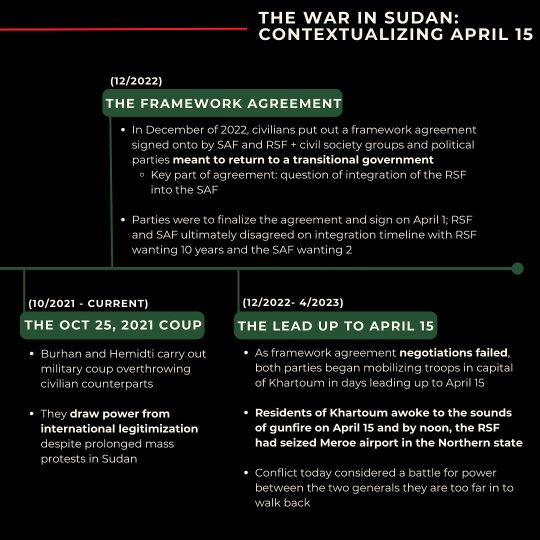
Transcript:
(10/2021 CURRENT)THE OCT 25, 2021 COUP
Burhan and Hemidti carry out military coup overthrowing civilian counterparts
They draw power from international legitimization despite prolonged mass protests in Sudan
(12/2022) THE FRAMEWORK AGREEMENT
In December of 2022, civilians put out a framework agreement signed onto by SAF and RSF + civil society groups and political parties meant to return to a transitional government
Key part of agreement: question of integration of the RSF into the SAF
Parties were to finalize the agreement and sign on April 1; RSF and SAF ultimately disagreed on integration timeline with RSF wanting 10 years and the SAF wanting 2
(12/2022-4/2023) THE LEAD UP TO APRIL 15
As framework agreement negotiations failed, both parties began mobilizing troops in capital of Khartoum in days leading up to April 15
Residents of Khartoum awoke to the sounds of gunfire on April 15 and by noon, the RSF had seized Meroe airport in the Northern state
Conflict today considered a battle for power between the two generals they are too far in to walk back

Transcript:
FRAMING ALLIANCES
Sudanese Armed Forces (SAF):
Egypt
Israel (Foreign Ministry)
Islamists
Iran
Saudi Arabia
Ukraine (SOF)
Armed Groups
Rebel groups that had taken up arms against the central government in the Bashir Era are forced to ally with the SAF due to the RSF's ethnic cleansing campaign. They include:
Justice and Equality Movement (Gibril Ibrahim)
Sudan Liberation Movement/Army (Minni Minawi)
Gathering of Sudan Liberation Forces (Abdallah Yahya)
Rapid Support Forces (RSF):
Israel (Mossad)
Libya (Khalifa Haftar)
United Arab Emirates
Central African Republic
Russia (Wagner Group)
Chad
Arab Tribal Leaders
Arab tribal leaders across the Western region of Darfur have pledged their allegiance and support to the RSF, with members of the tribes across the Sahel crossing into Sudan to join the RSF's assault as well.
Key tribes include: Beni Halba, Tarjam, Habaniya, Fallata, Misseriya, Taaysha, Rizeigat
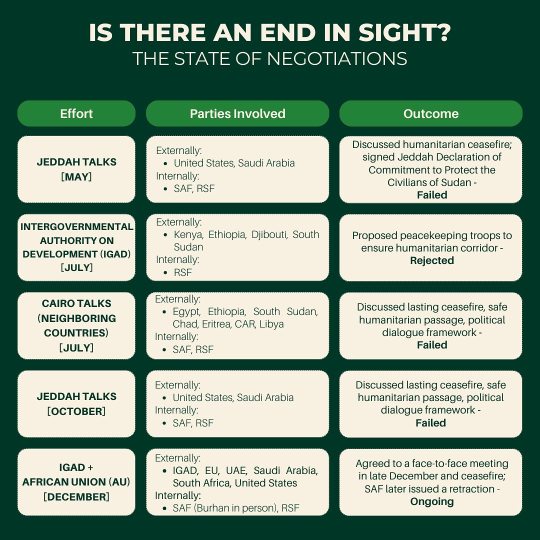
Transcript:
IS THERE AN END IN SIGHT?
THE STATE OF NEGOTIATIONS
Effort: JEDDAH TALKS [MAY]
Parties involved: Externally: United States, Saudi Arabia Internally: SAF, RSF
Outcome: Discussed humanitarian ceasefire; signed Jeddah Declaration of Commitment to Protect the Civilians of Sudan - Failed
Effort: INTERGOVERNMENTAL AUTHORITY ON DEVELOPMENT (IGAD) [JULY]
Parties Involved: Externally: Kenya, Ethiopia, Djibouti, South Sudan Internally: RSF
Outcome: Proposed peacekeeping troops to ensure humanitarian corridor - Rejected
Effort: CAIRO TALKS (NEIGHBORING COUNTRIES) [JULY]
Parties Involved: Externally: Egypt, Ethiopia, South Sudan, Chad, Eritrea, CAR, Libya Internally: SAF, RSF
Outcome: Discussed lasting ceasefire, safe humanitarian passage, political dialogue framework - Failed
Effort: JEDDAH TALKS [OCTOBER]
Parties Involved: Externally: United States, Saudi Arabia Internally: SAF, RSF
Outcome: Discussed lasting ceasefire, safe humanitarian passage, political dialogue framework - Failed
Effort: IGAD + AFRICAN UNION (AU) [DECEMBER]
Parties Involved: Externally: IGAD, EU, UAE, Saudi Arabia, South Africa, United States Internally: SAF (Burhan in person), RSF
Outcome: Agreed to a face-to-face meeting in late December and ceasefire; SAF later issued a retraction - Ongoing
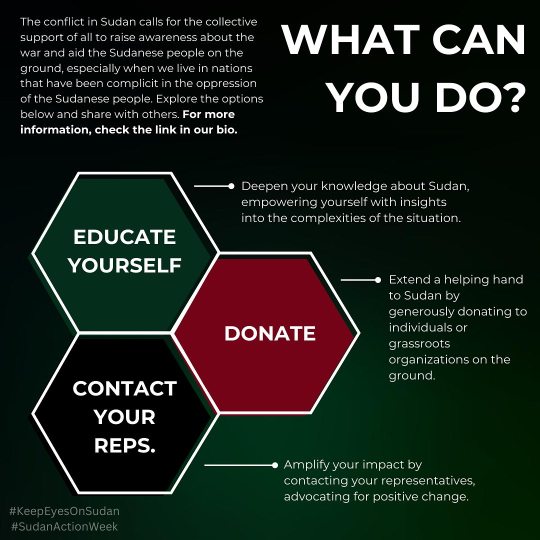
Transcript:
The conflict in Sudan calls for the collective support of all to raise awareness about the war and aid the Sudanese people on the ground, especially when we live in nations that have been complicit in the oppression of the Sudanese people. Explore the options below and share with others. For more information, check the link in our bio.
WHAT CAN YOU DO?
EDUCATE YOURSELF
Deepen your knowledge about Sudan, empowering yourself with insights into the complexities of the situation.
DONATE
Extend a helping hand to Sudan by generously donating to individuals or grassroots organizations on the ground.
CONTACT YOUR REPS.
Amplify your impact by contacting your representatives, advocating for positive change.
#sudan#keep eyes on sudan#KeepEyesOnSudan#Sudan Action Week#SudanActionWeek#i hope the way i formatted it is good#i saw a few hours ago that rsf retreated from wad madani outskirts
370 notes
·
View notes
Text
Chère Madame Connasse/ Dear Mrs. Fuckwit
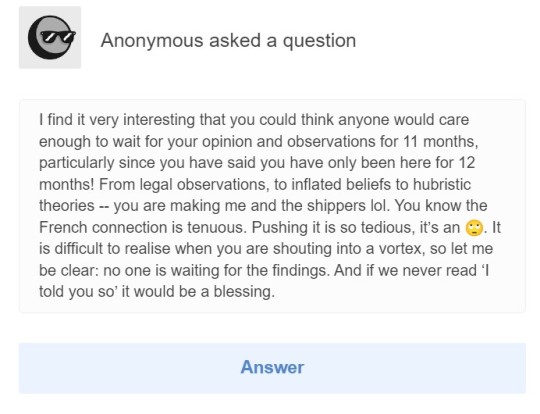
First of all, please excuse the length of this answer (you have also been blocked, incidentally speaking). This deserves its own audio. In French, since the French connection is so fucking tenuous:
Here is the English translation, since I am pretty sure Madame Connasse does not speak any French:
'Dear Mrs. Fuckwit,
Oh, well - how may I put it? I also find interesting that such an idiot would lose her time sending such enormous things to a page she hates and which, in return, cordially tells her to go fuck herself.
I usually am entitled to some pretty mighty garbage, but you do have enough vocabulary as to use words like 'hubristic' and 'vortex'. That makes you, by the way, very vulnerable and also more exposed than Uganda's current budget.
But why not you, after all, like so many others? The more, the merrier and you do write, not without some chutzpah, that my French connection is tenuous, as is my legal expertise and that I make you laugh, along with all the rest of the shipper community. Which, to be honest, is as untrue as possible. But it must be such a pain in the ass for you to see that people read me, that people like what I write and that, who knows, all those people (of which there are many), have a better day, in this bizarre environment.
I have already shown you some pictures of myself, including at official events. It was not enough.
I have already shown you my car, my office, my desk and my diplomatic passport. It was not enough.
With just one click you could have checked all the (very transparent) clues I have patiently scattered in my posts, in order for you to find me. Some did. They know perfectly well that you lie and you know it, too.
So, here's the deal, you stupid bitch: your cackle will turn sour when you'll see this very official paper:
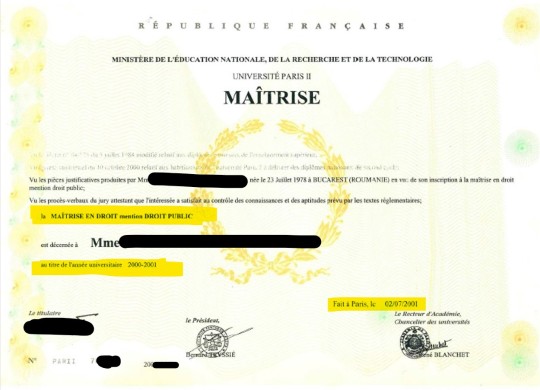
This is just one of my law degrees - my Public Law BA at the Paris II University, in June 2001, as you can see by yourself. I have worked so hard and so passionately to get it, that I don't give a flying fuck about the fact that a nobody, and a coward to boot, doubts me. I have nothing to prove, nothing to demonstrate and I owe you nothing. However, sometimes one must set the record straight and I am a very impulsive person, after all.
I shall spare you all the rest, dear Mrs. Fuckwit. There is much more, but I am afraid your self esteem could never bear it. That being said, think twice, the next time you'd try to humiliate someone you do not know. Internet is so wonderfully sketchy that you never know (pinky promise: like never, ever know) to whom you're really talking. People lie very easily in here: I find this ridiculous and useless, in 2024, when one can find more or less everything about anyone. In no time at all, provided one knows exactly how to do it (between you and me, it's not even that complicated).
You and your posse of Pointless Underlings have insulted and intimidated dozens and dozens of people of our community, with an absolutely revolting ferocity. You have been doing it for years, with complete impunity and the strong belief that you were protected by a particularly perverted context, by some obscure agendas and by the indifference of the Two Main Characters. I am here to tell you I am not afraid and also that I couldn't care less about whatever you'd write or think. You will do it again, of course, because I think your obsessive universe is limited to the tiny window of your delusions.
But don't worry, dear Mrs. Fuckwit: until further notice, I shall make mine what a distant descendant of Irish Rebels, marshal of France Mac Mahon, said during the Crimea War - I am here and I am here to stay.
Also, you know: she who laughs last laughs the best.'
90 notes
·
View notes
Text
At last, a funny and highly satisfying chapter! We meet someone new – a veteran of the Napoleonic wars, and someone whom we have already met — a barber who once chased away two of Gavroche’s kids from his shop. The barber asks the veteran flattering questions about the emperor and the veteran himself, and every answer is unwittingly hilarious. When he is asked if he has been wounded often, the veteran answers something like: Oh, this is nothing! And then, he goes on to list his numerous and quite serious wounds, making you wonder how he can still function.
And when the barber hypocritically claims that he would prefer to die with a cannonball in his belly (seriously? It’s such a painful and cruel death!) rather than in his bed, something crashes through the window and lands on the floor of the shop. “A cannonball!” But it’s only a stone thrown by Gavroche. Well done, boy! You deserve some fun: first tearing down the posters, now breaking the window as revenge! And we are left with the barber’s perplexed question: “What has any one done to that gamin?”
21 notes
·
View notes
Photo










The Bear Flag Revolt began on June 14, 1846. Anglo settlers in Sonoma, California, started a rebellion against Mexico and proclaimed the California Republic.
#Sonoma State Historic Park#rebellion#California Republic#summer 2022#evening light#Mission San Francisco Solano#architecture#cityscape#travel#General Mariano Guadalupe Vallejo by Jim Callahan#US flag#vacation#USA#Bear Flag Revolt#started#14 June 1846#anniversary#US history#public art#sculpture#exterior#tourist attraction#landmark
0 notes
Text
Let's talk about Sudan-
TRANSCRIPT UNDER CUT

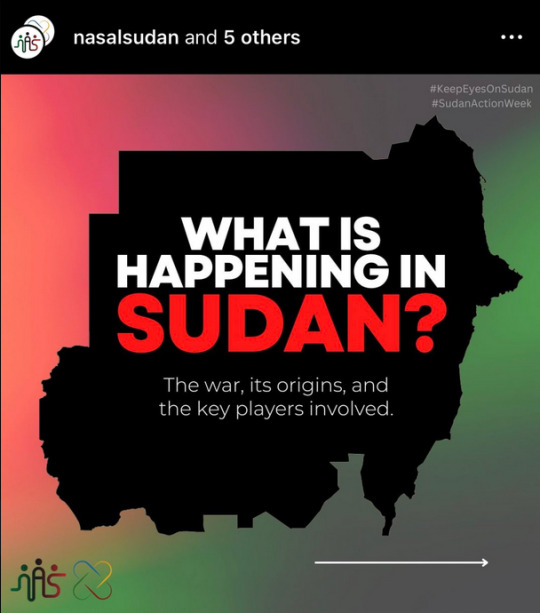
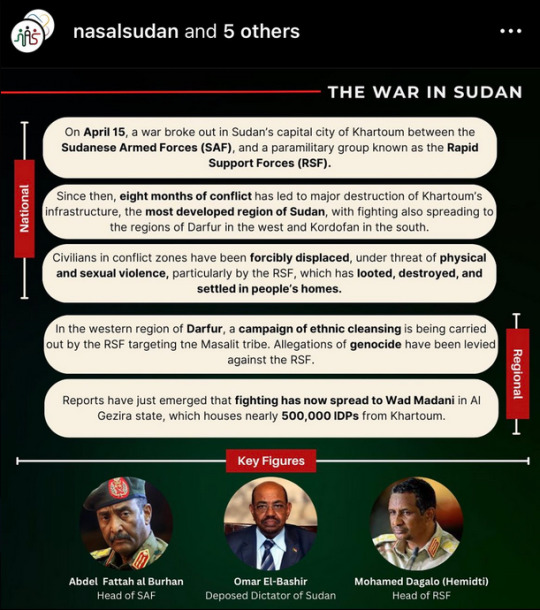
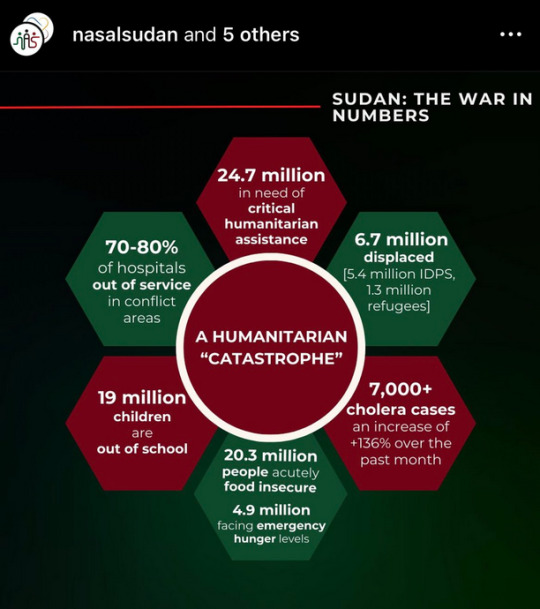

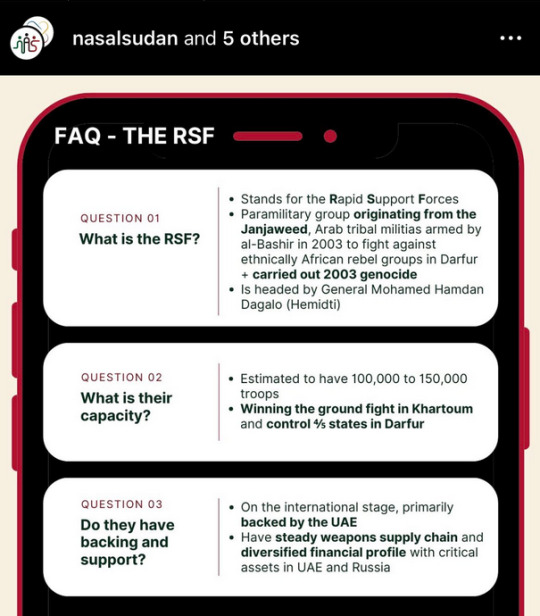
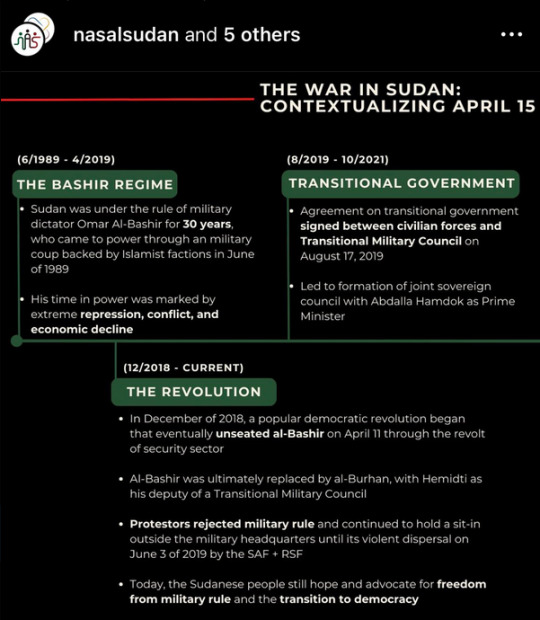
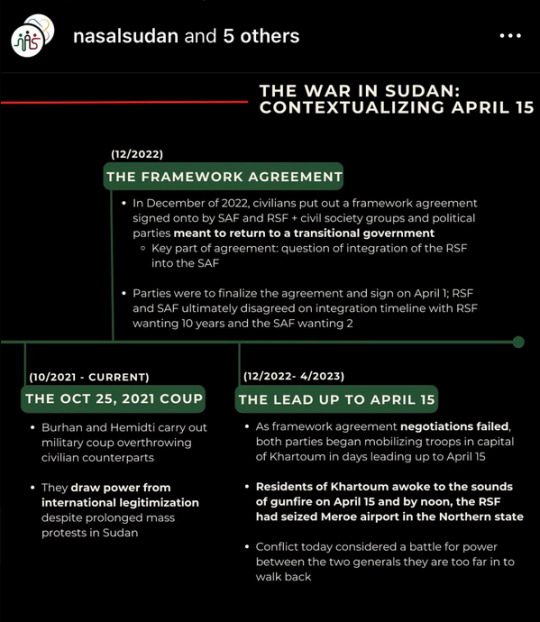
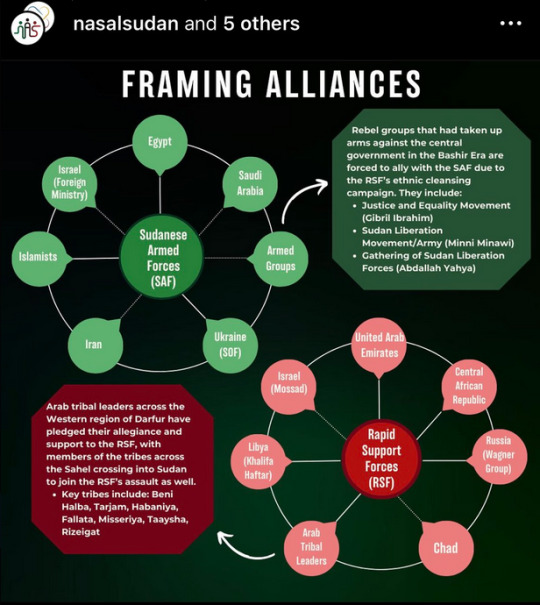
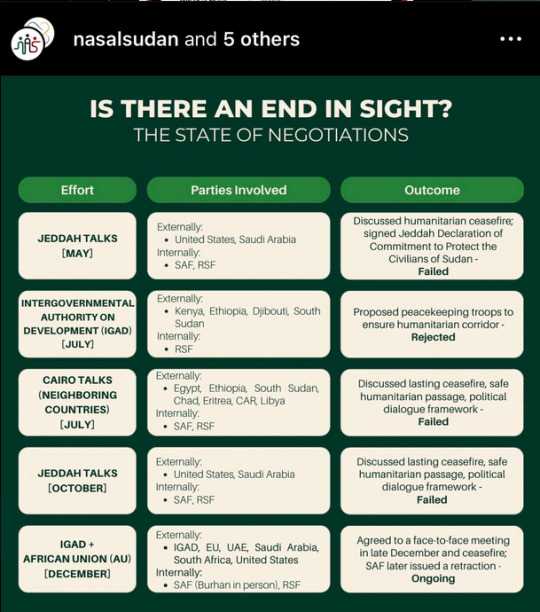

Transcript: What is happening in Sudan? The war, its origins, and the key players involved.
The war in Sudan
On April 15, a war broke out in Sudan's capital city of Khartoum between the Sudanese Armed Forces (SAF), and a paramilitary group known as the Rapid Support Forces (RSF). Since then, eight months of conflict has led to major destruction of Khartoum's infrastructure, the most developed region of Sudan, with fighting also spreading to the regions of Darfur in the west and Kordofan in the south.
Civilians in conflict zones have been forcibly displaced, under threat of physical and sexual violence, particulary by the RSF, which has looted, destroyed, and settled in people's homes.
In the western region of Darfur, a campaign of ethnic cleansing is being carried out by the RSF targeting the Masalit tribe. Allegations of genocide have been levied against the RSF.
Reports have just emerged that fighting has now spread to Wad Madani in AI Gazira state, which houses nearly 500,00 IDPs from Khartoum.
Key Figures: Abdel Fattah al Burhan (head of SAF), Omar El-Bashir (deposed dictator of Sudan), Mohamed Dagalo (Hemidti) (head of RSF)
Sudan: the war in numbers
24.7 million in need of critical humanitarian assistance 6.7 million displaced [5.4 million IDPS, 1.3 million refugees] 7,000+ cholera cases an increase of +136% over the past month 20.3 million people acutely food insecure- 4.9 million facing emergency hunger levels 19 million children are out of school 70-80% of hospitals out of service in conflict areas
FAQ - THE SAF
What is the SAF?
stands fro the Sudanese Armed Forces
is the de-facto government of Sudan
is headed by Lt. General Abdel Fattah al-Burhan
What is their capacity?
estimated to have aprox. 200,000 personnel and tactical advantage of airforce
currently control of relative northern and eastern regions of Sudan with functioning capital in Port Sudan (East)
Do they have backing and support?
on the international stage, primarily backed by Egypt
limited weapons supply from allies
internally, the SAF is ultimately considered the lesser of two evils
FAQ - THE RSF
What is the RSF?
stands fro Rapid Support Forces
paramilitary group originating from the Janjaweed, Arab tribal militias armed by al-Bashir in 2003 to fight against ethnically African rebel groups in Darfur + carried out 2003 genocide
is headed by General Mohamed Hamdan Dagalo (Hemidti)
What is their capacity?
estimated to have 100,000 to 150,000 troops
winning the ground fight in Khartoum and control 4/5 states in Darfur
Do they have backing and support?
on the international stage, primarily backed by the UAE
have steady weapons supply chain and diversified financial profile with critical assets in UAE and Russia
The war in Sudan: contextualizing April 15
6/1989 - 4/2019 - The Bashir Regime Sudan was under the rule of military dictator Omar Al-Bashir for 30 years, who came to power through an military coup backed by Islamist factions in June of 1989 His time in power was marked by extreme repression, conflict, and economic decline
12/2018 - current - The revolution In December of 2018, a popular democratic revolution began taht eventually unseated al-Bashir on April 11 through the revolt of security sector Al-Bashir was ultimately replaced by al-Burhan, with Hemidti as his deputy of a Transitional Military Council Protestors rejected military rule and continued to hold a sit-in outside the military headquarters until its violent dispersal on June 3 of 2019 by the SAF + RSF Today, the Sudanese people still hope and advocate for freedom from the military rule and the transition to democracy
8/2019 - 10/2021 - Transitional Government Agreement on transitional government signed between civilian forces and Transitional Military Council on August 17, 2019 Led to formation to joint sovereign council with Abdalla Hamdok as Prime Minister
10/2021 - Current - The Oct 25, 2021 Coup Burhan and Hemidti carry out military coup overthrowing civilian counterparts They draw power from international legitimization despite prolonged mass protests in Sudan
12/2022- The Framework Agreement In December of 2022, civilians put out a framework agreement signed onto by SAF and RSF + civil society groups and political parties meant to return to a transitional government - key part of agreement: question of integration of the RSF into the SAF Parties were to finalize the agreement and sign on April 1; RSF and SAF ultimately disagreed on the integration timeline with RSF wanting 10 years and the SAF wanting 2
12/2022-4/2023 - The Lead up to April 15 As framework agreement negotiations failed, both parties began mobilizing troops in capital of Khartoum in days leading up to April 15 Residents of Khartoum awoke to the sounds of gunfire on April 15 and by noon, the RSF had seized Meroe airport in the Northern state Conflict today considered a battle of power between the two generals they are too far in to walk back
Framing alliances
Sudnese Armed Forces (SAF):
Saudi Arabia
armed groups- rebel groups that had taken up arms against the central government in the Bashir Era are forced to ally with the SAF due to the RSF's ethnic cleansing campaign. They include: Justice and Equality Movement (Gibril Ibrahim), Sudan Liberation Movement/Army (Minni Minawi), Gathering of Sudan Liberation Forces (Abdallah Yahya)
Ukraine (SOF)
Iran
Islamists
Israel (Foreign Ministry)
Egypt
Rapid Support Forces (RSF):
United Arab Emirates
Central African Republic
Russia (Wagner Group)
Chad
Arab Tribal Leaders- Arab tribal leaders across the Western region of Darfur have pledged their allegiance and support to the RSF, with members of the tribes across the Sahel crossing into Sudan to join the RSF's assault as well. Key tribes include: Beni Halba, Tarjam, Habaniya, Fallata, Misseriya, Taaysha, Rizeigat
Libya (Khalifa Haftar)
Israel (Mossad)
Is there an end in sight? The state of negotiations
Effort- Jeddah Talks [May] Parties Involved- Externally: United States, Saudi Arabia. Internally: SAF, RSF Outcome: discussed humanitarian ceasefire; signed Jeddah Declaration of Commitment to Protect the Civilians of Sudan- FAILED
Effort- Intergovernmental authority on development (IGAD) [July] Parties Involved- Externally: Kenya, Ethiopia, Djibouti, South Sudan . Internally: RSF Outcome: proposed peacekeeping troops to ensure humanitarian corridor-REJECTED
Effort- Cairo talks (neighboring countries) [July] Parties Involved- Externally: Egypt, Ethiopia, South Sudan, Chad, Eritrea, CAR, Libya. Internally: SAF, RSF Outcome: discussed lasting ceasefire, safe humanitarian passage, political dialogue framework-FAILED
Effort- Jeddah talks [October] Parties Involved- Externally: United States, Saudi Arabia . Internally: SAF, RSF Outcome: discussed lasting ceasefire, safe humanitarian passage, political dialogue framework-FAILED
Effort- IGAD + African Union (AU) [December] Parties Involved- Externally: IGAD, EU, UAE, Saudi Arabia, South Africa, United States. Internally: SAF (Burhan in person), RSF Outcome: agreed to face-to-face meeting in late December and ceasefire; SAF later issued a retraction-ONGOING
What can you do?
The conflict in Sudan calls for the collective support of all to raise awareness about war and aid the Sudanese people on the ground, especially when we live in nations that have been complicit in the oppression of the Sudanese people. Explore the potions below and share with others. Educate yourself- deepen your knowledge about Sudan, empowering yourself with insights into the complexities of the situation. Donate- extend a helping hand to Sudan by generously donation to individuals or grassroots organizations on the ground.
Contact your reps- amplify your impact by contacting your representatives, avocating for positive change
226 notes
·
View notes
Note
Was suicide really seen as noble during the French Revolution? Was there any recorded tension regarding this cultural shift with more religious or less revolutionary people/groups? Thanks!
In the book La liberté ou la mort: mourir en député 1792-1795 (2015) can be found a list of all the deputies of the National Convention that died unnatural deaths between 1792 and 1799. Of the 96 names included on it, 16 were those of suicide victims, and to these must also me added a number of botched suicide attempts as well.
Only a single one of these suicides appears to have been driven by something outside of politics, that of the deputy Charlier, who shot himself in his apartment on February 23 1797, two years after the closing of the Convention. The rest of the suicides are all very clearly politically motivated, more specifically, deputies killing themselves just as the machinery of revolutionary justice was about to catch up to them. There’s those who killed themselves while on the run and unsheltered from the hostile authorities — the girondin Rebecqui who on May 1 1794 drowned himself in Old Port of Marseille, Pétion and Buzot who on June 24 1794 shot themselves after getting forced to leave the garret where they for the last few months had been hiding out, Maure who shot himself while in hiding on 3 June 1795 after having been implicated in the revolt of 1 Prairial, Brunel, who on May 27 shot himself after failing to quell a riot in Toulon, and Tellier, who similarily shot himself on September 17 1795 due to a revolt directed against him in the commune of Chartres. Barbaroux too attempted to shoot himself on June 18 1794 but only managed to blow his jaw off. He was instead captured and guillotined. There’s those that put an end to their days once cornered by said authorities — Lidon, who on November 2 1793 shot himself after having been discovered at his hiding place by two gendarmes (he did however first fire three shots at said gendarmes, one of whom got hit in the cheek) and Le Bas who shot himself in the night between July 27 and 28 1794 as National guardsmen stormed the Hôtel de Ville where he and his allies were hiding out (according to his wife’s memoirs, already a few days before this he had told her that he would kill them both right then and there wasn’t it for the fact they had an infant son). In an interrogation held two o’clock in the morning on July 28 1794, Augustin Robespierre too revealed that the reason he a few hours earlier had thrown himself off the cordon of the Hôtel de Ville was ”to escape from the hands of the conspirators, because, having been put under a decree of accusation, he believed his death inevitable,” and there’s of course an eternal debate on whether or not his older brother too had attemped to commit suicide at Hôtel de Ville that night or if he was shot by a guard (to a lesser extent, this debate also exists regarding Couthon). There’s those who committed suicide in prison to avoid an unfriendly tribunal — Baille who hanged himself while held captive in the hostile Toulon on September 2 1793, Condorcet who took poison and was found dead in his cell in Bourg-la-Reine on 29 March 1794 (though here there exists some debate on whether it really was suicide or if he ”just” died from exhaustion) and Rühl, who stabbed himself while in house arrest on May 29 1795. On March 17 1794, Chabot tried to take his life in his cell in the Luxembourg prison by overdosing on medicine (he reported that he shouted ”vive la république” after drinking the liquor) but survived and got guillotined. Finally, there’s those who held themselves alive for the whole trial but killed themselves as soon as they heard the pronounciation of the death sentence — the girondin Valazé who stabbed himself to death on October 30 1793 and the so called ”martyrs of prairial” Duquesnoy, Romme, Goujon, Bourbotte (in a declaration written shortly before his death he wrote: ”Virtuous Cato, no longer will it be your example alone that teaches free men how to escape the scaffold of tyranny”), Duroy and Soubrany who did the same thing on June 17 1795 (only the first three did however succeed with their suicide, the rest were executed the very same day).
To these 24 men must also be added other revolutionaries that weren’t Convention deputies, such as Jacques Roux who on February 10 1794 stabbed himself in prison, former girondin ministers Étienne Clavière who did the same thing on December 8 1793 (learning of his death, his wife killed herself as well) and Jean Marie Roland who on November 10 1793 ran a sword through his heart while in hiding, after having been informed of his wife’s execution, Gracchus Babeuf and Augustin Darthé who attempted to stab themselves on May 27 1797 after having been condemned in the so called ”conspiracy of equals,” but survived and were executed the next day, as well as two jacobins from Lyon — Hidins who killed himself in prison before the city got ”liberated,” and Gaillard who did the same thing shortly after the liberation, after having spent several weeks in jail.
With all that said, I think you could say taking your life was considered ”noble” in a way, if it allowed you to die with greater dignity than letting the imposition of revolutionary judgement take it instead did. It was at least certainly a step up compared to before 1789, when suicide (through the Criminal Ordinance of 1670) was considered a crime which could lead to confiscation of property, opprobium cast on the victim’s family and even subjection of the courpse to various outrages, like dragging it through the street. To nuance this a bit, it is however worth recalling that this was only in theory, and that in practise, most of these penalties had ceased to be carried out already in the decades before the revolution, a period during which suicide, in the Enlightenent’s spirit of questioning everything, had also started getting discussed more and more. The word ”suicide” itself entered the French dictionary in 1734. Most of the enlightenment philosophes reflected on suicide and the ethics behind it. There’s also the widely spread The Sorrows of Young Werther that was first released in 1774. Furthermore, most revolutionaries were also steeped in the culture of Antiquity, where suicide was seen as an admirable response to political defeat, perhaps most notably those of Brutus and Cato the younger, big heroes of the revolutionaries. Over the course of the revolution, we find several patriotic artists depicting famous suicides of Antiquity — such as Socrates (whose death is considered by some to have been a sort of suicide) (1791) by David, The Death of Cato of Utica (1795) by Guillaume Guillon-Lethière, and The death of Caius Gracchus (1798) by François Topino-Lebrun. According to historian Dominique Godineau, the 18th century saw ”the inscription [of suicide] in the social landscape, at least in large cities: it has become “public,” people talk about it, it is less hidden than at the beginning of the century,” and she therefore argues that the decision to decriminalize it in the reformed penal code (it didn’t state outright that suicide was now OK, but it no longer listed it as a crime) of 1791 wasn’t particulary controversial.
Furthermore, that committing suicide was more noble than facing execution was still far from an obvious, universal truth during the revolution. In his memoirs, Brissot does for example recall that, right after the insurrection of August 10, when he and other ”girondins” discussed what to do was an act of accusation to be issued against them, Buzot argued that ”the death on the scaffold was more courageous, more worthy for a patriot, and especially more useful for the cause of liberty” than committing suicide to avoid it. The feared news of their act of accusation did however arrive before the girondins had reached a definitive conclusion on what to do, leading to some fleeing (among them Buzot, who of course ironically ended up being one of the revolutionaries that ultimately chose suicide over the scaffold) and some calmly awaiting their fate. In her memoirs, Madame Roland did her too consider going to the scaffold with her head held high to be an act of virtue — ”Should I wait for when it pleases my executioners to choose the moment of my death and to augment their triumph by the insolent clamours of the mob to which I would be exposed? Certainly!” In his very last speech to the Convention, convinced that his enemies were rounding up on him, Robespierre exclaimed he would ”drink the hemlock,” a reference to the execution of Socrates. The girondin Vergniaud is also said to have carried poison on him but chosen to have go out with his friends on the scaffold, although I’ve not yet discovered what the source for this is. It can also be noted that the number of Convention deputies who let revolutionary justice have its course with them was still considerably higher than those who attempted to put an end to their days before the sentence could be carried out.
According to Patterns and prosecution of suicide in eighteenth-century Paris (1989) by Jeffrey Merrick, there was indeed tension regarding the rising amount of suicides in the decades leading up to the revolution. Merrick cites first and foremost the printer and bookseller Siméon Prosper Hardy, who in his journal Mes loisirs ou journal des evenements tels qu'ils parviennent a ma connaissance (1764-1789), documented a total of 259 cases of Parisian suicides. Hardy saw these deaths as an unwelcome import from the English, who for their part were led to kill themselves due to ”the dismal climate, unwholesome diet, and excessive liberty.” He also blamed the suicides on "the decline of religion and morals," caused by the philosophes, who in their ”bad books” popularized English ways of thinking and undermined traditional values. He was not alone in drawing a connection between the suicides and the new ideas. According to Merrick, the clergy in general ”denounced the philosophes for legitimizing this unforgiveable crime against God and society, which they now associated with systematic unbelief more than the traditional diabolical temptation.” In practice, many parish priests did however still quietly bury the bodies of persons who killed themselves. The future revolutionary Louis Sébastien Mercier did on the other hand blame the government and its penchant for inflated prices and burdensome taxes for the alleged epidemic of suicides in his Tableau de Paris (1782-1783).
In La liberté ou la mort: mourir en député, 1792-1795 it is also established that there weren’t that many participants of the king that killed themselves once the wind started blowing in the wrong direction, but that is not to say they didn’t exist. As example is cited the case of a man who in April 1793 shot himself on the Place de la Révolution, before having written ”I die for you and your family” on a gravure representimg the head of Louis XVI. There’s also the case of Michel Peletier’s murderer Philippe Nicolas Marie de Pâris, royalist and former king’s guard, who, similar to Lidon, blew his brains out when the authorities had him cornered a week after the murder.
Sources:
Patterns and prosecution of suicide in eighteenth-century Paris (1989) by Jeffrey Merrick
Pratiques du suicide à Paris pendant la Révolution française by Dominique Godineau
La liberté ou la mort: mourir en député, 1792-1795 (2015) by Michel Biard, chapter 5, ”Mourir en Romain,” le choix de suicide.
Choosing Terror (2014) by Marisa Linton, page 276-279, section titled ”Choosing how to die.”
#well. this is depressing 😀#frev#french revolution#ask#would tag everyone that (tried to) killed themselves but that would take ages
60 notes
·
View notes
Text

"Revolt for Nahel"
Graffiti in memory of 17-year-old Nahel M, who was murdered by police on June 27 in the western Parisian suburb of Nanterre, sparking an ongoing rebellion in cities across France.
503 notes
·
View notes